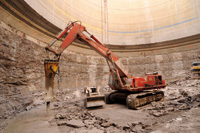Atlas Copco: Breaking through bedrock Ric-Man Construction Inc. has ventured into caisson work with construction of a combined sewer overflow facility in Dearborn, Michigan. Designed to hold 13,2 billion liters, this facility is one of the larger ones currently under construction in the region. The project began in January 2008 with a substantial rock grouting and stabilization program. The water elevation is actually higher than the ground elevation in this area, so this phase was necessary to eliminate any water infiltration during excavation and construction of the caisson, which began in January 2009. The self-sinking caisson was poured in eight separate vertical lifts. The company used six Atlas Copco BBC 34W pusher leg mounted rock drills from Stockdale Mine Supply to drill more than 400 holes for bolt installation in the vertical face of the rock during construction of the caisson wall. The rock bolts were used to secure wire mesh to the face. 15 cm of shotcrete have been sprayed to seal off the rock, and then the final concrete was poured. Lift 8 of the caisson was on bedrock at - 42 meters. To pour the caisson's bowl-shaped slab, they would have to remove and excavate 11000 cubic meters of bedrock, or an additional 15 meters of material. At this point, the construction team had to decide whether to drill and blast the bedrock for excavation, or bring in hydraulic breakers to accomplish the task. They went with the breakers.
Most projects in the Dearborn region depend on drilling and blasting to remove bedrock, so there was very little history to refer to regarding mechanical removal or excavation. So, Ric-Man began extensively researching hydraulic breakers and reached the decision to contact Atlas Copco distributor AIS Construction Equipment, which pointed them in the direction of Scott Hendricks, Area Sales Manager for Atlas Copco.
To begin the process, two Atlas Copco ECM 590 drill rigs were lowered into the caisson to predrill 600 relief holes into the bedrock. The 5cm and 7,5cm holes were drilled to a depth of 14 meters on 1,2 meter centers. Relief holes make it easier for the hydraulic breakers to break the material by giving the impact energy somewhere to go, increasing productivity. Without the relief holes, the solid bedrock would just absorb the impact energy. Once the relief holes were drilled, they brought in a 77 tones Koehring 1066 excavator to handle first the HB 7000 and then the HB 10000 hydraulic breakers. The company initially started using the HB 7000, but then opted to bring in the HB 10000 to increase productivity on the bedrock.
Ric-Man completed excavation of the bedrock by December 2009 and then poured the base slab of the caisson. The final lift, lift 9, was the caisson's cap, which sits at ground level. Caisson construction was completed in April. Following that, they completed all of the sewer connections, bringing the interceptors to the structure. They also built the control building on site. The final phase of the project will be landscaping the site. The entire project is scheduled for completion by July 2010. 23/11/2010 |